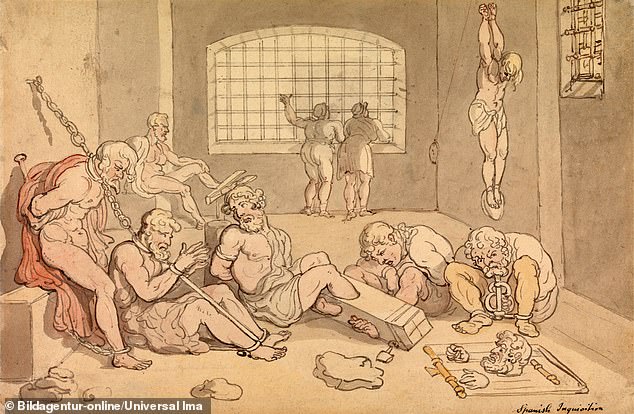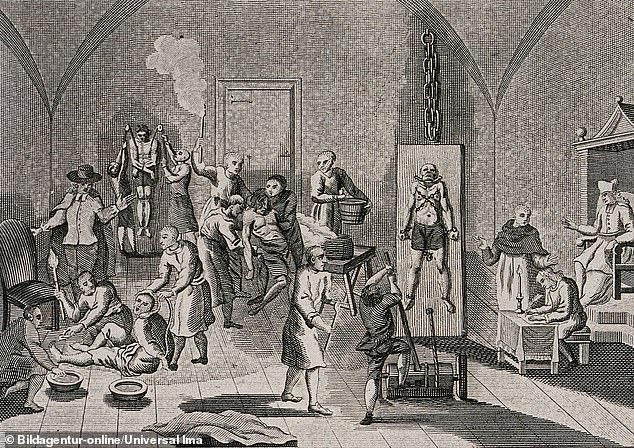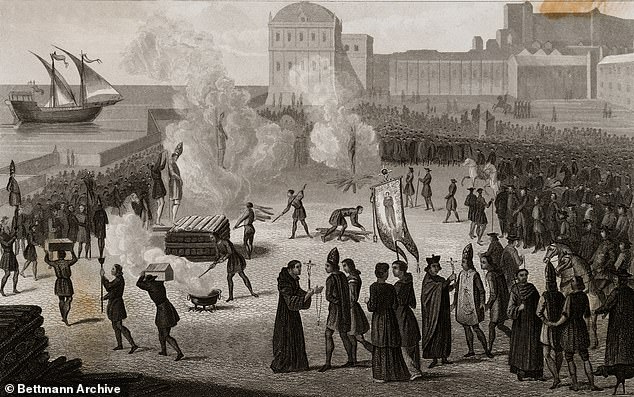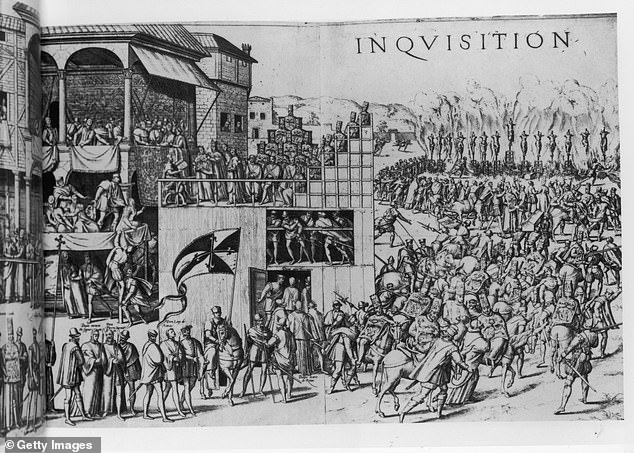Stretched 12 inches on the rack, crushed in iron maidens… or killed with an 'anal pear': Terrifying tortures employed by the Spanish Inquisition - one of the first groups to use waterboarding - to force confessions... or execute non-believers
Beyond its endless sunshine and sandy beaches, Spain has a dark history that has stained the nation to this day.
For hundreds of years, people were burned at the stake, stretched to death, or otherwise tortured for the sole reason that they were not Catholic.
The Spanish Inquisition is considered to be one of the most shameful and grotesque periods in Roman Catholic history. According to some modern estimates, around 150,000 people were prosecuted for various offences during the three-century duration of the reign of terror, of whom between 3,000 and 5,000 were executed after enduring some of the most spine chilling acts of torture imaginable.
Extensive archival material contains accounts of torture victims' cries and descriptions of funeral pyres, atrocities which continue to horrify historians to this day.
The horrors of the Inquisition are among some of the most sadistic acts of terror in history, which extended into every area of Spanish society and almost every corner of its global empire.

Illustration of Tomas de Torquemada, Grand Inquisitor of the Spanish Inquisition, with King Ferdinand II and Queen Isabella in 1478

The Spanish Inquisition was a council to combat heresy, authorised by a papal bull in 1478 and established by King Ferdinand II and Queen Isabella of the Crown, in 1480

The Tribunal of the Holy Office of the Inquisition, commonly known as the Spanish Inquisition, was established in 1478 by Catholic Monarchs Ferdinand II of Aragon and Isabella I of Castile. It was intended to maintain Catholic orthodoxy in their kingdoms and to replace the Medieval Inquisition, which was under Papal control
In 1478, when the Christian kings of Castile began their Reconquest, they consolidated their power in the monarchy and the newly unified Spanish Kingdom of Castile and Aragon through brutal methods that led to widespread death and suffering, all in the name of maintaining Catholic orthodoxy in their kingdoms.
The Inquisition was characterised by secret procedures, the use of vicious and dehumanising torture methods during interrogations and the complete lack of rights for the accused.
One of the main torture devices was the rack, a device consisting of a rectangular, usually wooden frame, slightly raised from the ground, with a roller at one or both ends. The victim's ankles would be fastened to one roller and the wrists chained to the other. As the interrogation would progress, a handle attached to the top roller would be used very gradually to retract the chains, slowly increasing the strain on the prisoner's shoulders, hips, knees, and elbows and causing excruciating pain.
If the roller was turned too far, it could lead to the dismemberment of limbs.
Just by seeing the horrific pain endured by someone, others who were awaiting interrogation would confess to anything, just to avoid being tortured.
The rack would usually be used in two instances. The first lasted several turns, with the intention of frightening the prisoner. After, the machine would be stopped and the victim was told to 'speak'. If they did not confess, they would be succumbed to another round of interrogation and torture.
Victims could be cruelly stretched by up to 30 centimetres, the pain unbearable. After just a few turns, the sufferer would not be able to stand up or walk. In many cases, defendants died.
Another harrowing method was the use of the pulley. Here, the hands of the accused would be tied behind their back and the rope looped over a brace in the ceiling of the chamber or attached to a pulley. Then the subject would be raised from their arms, with the aim of pulling the shoulders out of their sockets.
Sometimes, the torturers added a series of drops, jerking the subject up and down. Weights could be added to the ankles and feet to make the hanging even more painful.
Another common torture method used by inquisitors was waterboarding, also referred to as 'toca' or 'tortura del agua'.

Victim of the Spanish Inquisition being tortured before a tribunal of the Spanish Inquisition. The Inquisition was established by the Spanish monarchy in 1478

The interior of a prison of the Spanish Inquisition with a priest overseeing his scribe while men and women are hung from pulleys, tortured on the rack or burned with torches, The Spanish Inquisition was a council to combat heresy, authorised by a papal bull in 1478 and established by King Ferdinand II and Queen Isabella of the Crown, in 1480

Jews being expelled from Spain during the Inquisition
There were several different versions of this torture method, but the most basic one consisted of water being poured down their throat to produce the sensation of drowning. In many cases, the victim would become unconscious from this.
This practice was perfected over the next few centuries, a method that is still used today by some intelligence agencies. This would consist of covering a person's face with a cloth and pouring water over it, producing extreme physical suffering and an uncontrollable feeling of panic and terror within seconds.
This form of torture had a profound religious significance to inquisitors, as it left no marks and didn't draw any blood.
In fact, inquisitors were among the first to use waterboarding. The first use of water torture has been attested to have taken place in 1516 in Graz, Austria, and the Spaniards extensively used the method in its detention centres throughout the course of the 1500s.
The US' CIA has admitted to having used this torture method against war prisoners, which included the masterminds behind the 9/11 attacks in 2001.
In 2020, the psychologist behind the CIA's post-9/11 interrogation program said that the waterboarding technique was so gruesome that even officials cried when witnessing the act.

Tomas de Torquemada, the first Grand Inquisitor of the Tribunal of the Holy Office

Torquemada is known for his ruthlessness during the Spanish Inquisition, and is known for his treatment of Jews and Muslims in Spain through the use of torture
Inquisitors also used thumb crushers to get confessions out of people, a metal instrument in which thumbs and toes were inserted in. A screw would then be used to twist fingers several times until the appendages broke.
The vaginal, oral or anal pear was another horrific torture method used by Spanish inquisitors. As the name suggests, a pear-shaped torture instrument was inserted into the mouth, vagina or anus of the victim. It would then expand by the turning of a screw, causing mutilation. Oral torture was used on preachers and prisoners with anti-Christian tendences, while vaginal torture was inflicted on women guilty of witchcraft. Anal torture targeted people accused of homosexuality. This act would almost always result in death.
The Iron Maiden was possibly one of the cruelest acts of punishment used during the Inquisition, however, it is thought to have not been used as frequently as other methods due to its severity. A prisoner would be placed into a human-shaped sarcophagus with two doors. The device had several metal spikes inside which, when the coffin was closed, pierced the flesh of the defendant, causing incredible pain. However, several historians have argued that this torture device was in fact not used during the Spanish Inquisition and in fact did not come into existence before the 1800s.
During the Inqusition, when torture was administered and no confession was obtained, the logical conclusion would be that the accused was innocent. But in most cases, defendants would say anything to prevent being tortured.
Other inquisitors used starvation and forced the accused to consume and hold vast quantities of water and other liquids. Others would heap burning coals on their body parts.
However, these were considered 'mild' torture methods, and didn't always work fast enough for the liking of inquisitors who were trying to get confessions out of people.
They would also parade their victims through the streets in chilling displays of punishment.
This created an atmosphere of terror that penetrated every aspect of society, weighing heavily on the psychology of the Spanish kingdom's citizens.
The inquisitors' main victims were Jews, who would be tortured and interrogated.
Trials, also known as 'auto de fes' originated with secret denunciations, and in most cases lasted years.
Inquisitors needed to extract a confession because they believed it was their duty to bring the accused back to the Christian faith.
A true confession resulted in the accused being forgiven, but he was usually still forced to absolve himself by going on pilgrimages or wearing multiple, heavy crosses.
But if they were found guilty, they were condemned in callous public rituals, often attended by the king in which they were forced to wear sinister hooded robes.
They would then be publicly tortured and then garrotted.

The Spanish Inquisition was a council for combating heresy, authorised by a papal bull in 1478 and established by King Ferdinand II and Queen Isabella of the Crown

Heretics are persecuted by members of the Catholic Church in the Spanish Inquisition
Capital punishment did allow for burning at the stake, while others were forced to become galley slaves or sent to prison.
In some cases, accused heretics who had died before their final sentencing had their corpses or bones dug up, burned and cast out.
The Catholic Monarchs' reign of terror led to some of the most vicious acts of violence on different members of Spanish society. But how exactly did the Inquisition come to be?
For 700 years, Spain was Islamic and Arabic. At its most powerful, Muslim Spain, known as Al Andalus, was a caliphate. The capital Cordoba, in southern Spain, was also home to a huge Jewish population, who were tolerated by Muslims, and generally had a peaceful coexistence.
But Al Andalus was in decline and when the Christian kings of Castile in the north began their Reconquest in the 13th century, they strove to consolidate their power by maintaining Catholic orthodoxy in their kingdom.
To achieve this, Ferdinand II of Aragon and Isabella I of Castile established the Holy Office of the Inquisition, or the Spanish Inquisition in 1478, a judicial institution.
Under a decree issued by Pope Sixtus IV, the Catholic Monarchs were able to enforce religious uniformity to expel Jews from Spain so that they could increase their absolute power.

Engraving depicting the Spanish Inquisition
Trying to escape violence, hundreds of thousands of Jews and Muslims converted to Christianity, but in 1492, Ferdinand and Isabella conquered the last Muslim emirate of Granada and ordered the expulsion of all Jews, unless they converted.
It is estimated that somewhere between 50,000 to 200,000 left Spain, and those who remained became real Christians.
However others still practised Judaism in secret and became known as crypto-Jews, whose prayerbooks were Latin on the outside but Hebrew on the inside, making them a threat to the Spanish Crown.
But this meant inquisitors were even more suspicious of people's religious identities, using torture methods as a means to get the truth out of people.
By 1483, the pope allowed the Spanish government to name a grand inquisitor to act as head of the Inquisition.
Tomas de Torquemada was selected as the first inquisitor, whose name became associated with the brutalities, religious bigotry and cruel fanaticism of the Inquisition.
He was convinced that the existence of 'Marranos' (Jewish converts), 'Moriscos' (Muslim converts), Jews and Moors was a threat to Spain's religious and social life.

An auto-da-fe, or act of faith, of the Spanish Inquisition held in the Plaza Mayor, Madrid, Spain

Inquisitional proceedings: Auto-da-fe on the Plaza Mayor in Madrid, before Charles II (Carlos II, 1661-1700), 30 June 1680. After the trial of 118 accused -among them, 104 Jews
As grand inquisitor, he issued 28 articles that outlined crimes that could be investigated by inquisitors as well as methods for interrogation and punishment.
The offenses included heresy, apostasy, sorcey, polygamy and blasphemy, among other things.
He established tribunals in Seville, Jaen, Cordoba, Ciudad Real and Zaragoza, where people were sent to torture chambers as inquisitors masked in leather would inflict pain on them.
His implacable hostility towards the Jews is thought to be one of the reasons Ferdinand and Isabella decided to expel the religious group from their dominions.
While the Jewish population in Spain was viciously targeted during the Spanish Inquisition, the religious fervour of the Catholic Monarchs also led to the persecution of Muslims and protestants.
In 1507, when Francisco Cardinal Jimenez de Cisneros was named gran inquisitor, he promoted the suppression of the Muslim population of Spain with the same zeal that Torquemada had directed at Jews.

Isabella I of Castile was the Queen of Castile and León, and the wife of King Ferdinand II. She was also Queen of Aragon from 1479 until her death as the wife of King Ferdinand II. Reigning together over a dynastically unified Spain, Isabella and Ferdinand are known as the Catholic Monarchs

Ferdinand II of Aragon, King of Spain. Ferdinand (1452-1516) married Isabella of Castille in 1469, uniting the kingdom of Spain. They sought to use the Inquisition to maximise their power
By 1609, some 300,000 Spanish Muslims were expelled.
While the monarchs wanted to consolidate their Catholic kingdom, money was another motivation for the Spanish Inquisition, as they funded themselves by seizing the property of those they punished.
They grew rich from destroying Jews and seizing their fortunes, and by 1500 Isabella, Ferdinand and the Spanish nobility owned 95% of land in their kingdom.
In addition, inquisitors would often order that a heretic's house be torn down and everything else the heretic possessed be confiscated and sold.
Monetary fines would also be imposed on those who were considered heretics, but if they were already dead, their children would be fined.

English merchant Nicholas Burton is tortured by officers of the Spanish Inquisition whilst imprisoned in Cadiz, 1560. He converted several of his fellow prisoners to the Protestant faith before he was martyred at the stake in Seville, on 20th December 1560

Circa 1500, A prisoner undergoing torture at the hands of the Spanish Inquisition. He is trapped to a revolving wheel below which a fire is being fanned with bellows. Monks in the background wait for his confession with quill and paper
Individual inquisitors also managed to acquire great wealth during their careers, as they were known to have fabricated evidence in order to extort money from their victims.
They were even known to keep meticulous financial records about the price of torture equipment, for example, by logging the cost of the rope used to tie the hands of someone burnt at the stake.
Another feature of the Spanish Inquisition were the Holy Office's instruction manuals, which were essentially a set of rules inquisitors had to follow.
However, historians have argued that more often than not, inquisitors would devise their own personal versions of inquisitorial practice for their own personal gain.
While the Spanish Inquisition ended permanently by the Spanish queen regent Maria Cristina de Borbon in 1834, the effects of the Spanish Inquisition linger to this day, as the country is making steps to come to terms with its longstanding troubled history of antisemitism.

Inquisition Scene, 1851 (oil on canvas)
In recent years Spain has sought to confront its mistreatment of Jews by, for example, granting the descendents of those expelled from Spain during the Inquisition to obtain Spanish citizenship.
Just 10 years ago, the Spanish village of Castrillo Matajudios - which translated to Camp Kill Jews - had to officially change its name to Castrillo Mota de Judios (Jews' Hill Camp) following a referendum and regional government approval.
Documents show the village's original name was Jews' Hill Camp and that the Kill Jews name dates from 1627, in the midst of the Spanish inquisition.
Although Jews were killed in the area, researchers believe the village got its name from Jewish residents who converted to Catholicism and wanted to reinforce their repudiation of Judaism to convince Spanish authorities of their loyalty.
A landmark exhibition last year at Madrid's Prado museum put a spotlight on the religious persecution of Jews, as the gallery aimed to tell Spain's troubled history through art.
The exhibition, 'The Lost Mirror: Jews and Conversos in Medieval Spain' displayed artefacts belonging to persecuted Jews and conversos; a reminder of the thousands of people tortured, killed or expelled during Spain's reign of terror.





























































































































































































































































































